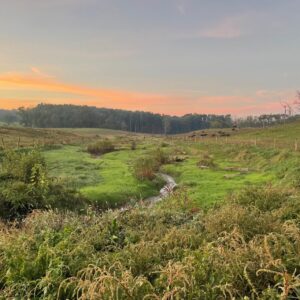
They might seem an odd couple, Crassostrea virginica and Castor canadensis — the Eastern oyster and the North American beaver.
But ecologically, for the Chesapeake Bay, the mollusk and the rodent are a lovely pairing, a compelling linkage of water and watershed.
Both were keystone species, the one’s dense reefs and the other’s ubiquitous damming and ponding create habitat and enhance water quality to the benefit of a host of other species.
Both have been reduced by overharvesting or pollution to a sliver of their historic abundance. This happened so long ago that today we suffer societal amnesia about how the Chesapeake’s bottom and its landscapes looked and functioned for thousands of years before Europeans shattered the natural order.
The oyster part of the story has been emerging, with scientific estimates that the Bay’s original stocks filtered and cleansed water equivalent to the estuary’s entire volume every several days. Today’s remnant oysters take months or more than a year.
But we still scarcely comprehend the immense habitat value for other estuarine life attracted to the countless nooks and crannies of the extensive, vertical reefs that oysters built. That’s because in modern times it has seemed natural for oysters to be spread widely and thinly across the Bay’s bottom. An 1869 account described a “continuous oyster bed” stretching 140 miles along the Eastern Shore, from Kent Island in Maryland to Cape Henry in Virginia.
But the current “natural” state is an artifact of more than a thousand dredge boats and many thousands of tongers, breaking apart and scattering the natural reefs before science could even understand their nature.
And the new order might have seemed an improvement, as oysters freed from reefs grew faster, shapelier, easier to harvest — never mind the lost habitat and new vulnerability to smothering by sediment.
The beavers’ tale is similar. For millennia, they inhabited virtually every stream of the 64,000-square-mile Bay watershed; and they controlled how the land shed water — cleanly, clearly, slowly — in a manner almost unrecognizable today.
We understand how green the precolonial Bay watershed was; we seldom realize how wet it was.
I got a glimpse of that well-beavered landscape on a recent foray with stream restoration expert Scott McGill. He wanted to show me his cutting-edge transformation of a half-mile-long, badly eroding gully that flows through Baltimore County into the Big Gunpowder River, a Chesapeake tributary.
This Holy Grail of restored streams looked … well, horrible. It was not the picture-postcard babbling brook that meanders, pools and riffles in an eye-pleasing cascade of sparkling water contained by forested banks. That is the stuff of calendars and posters and is “natural” only in our historical and ecological blindness, McGill said.
Instead, he had just bulldozed the gully’s 12-foot banks into the channel, along with all of the surrounding trees, resulting in, its creator said proudly, “a muddy mess.”
We could mostly hear the water, down there somewhere, gurgling, oozing, glinting occasionally from beneath a morass of mud and decaying logs.
Almost unwalkable, it recalled the landscapes that often caused the 1804 Lewis and Clark expedition to abandon the stream valleys for the slopes. The reason: Beavers had dammed and ponded everywhere, creating broad, shrubby, soggy meadows. The single channel stream that is today’s ideal was in fact more the exception than the rule.
On the Chesapeake, it was the same. Rainfall did not rush to the Bay. It oozed and seeped, soaked into the ground, then reappeared, its energy dissipated through multiple flow ways.
Sediment settled out in ponds behind dams that might occur every 50 yards on some streams. Nitrogen, the Bay’s prime pollutant today, was digested in the beaver-created wetlands and turned to harmless nitrogen gas. And the ponded landscape was lush with waterfowl and all manner of amphibians, not to mention otter and muskrat.
As with oyster reefs, those landscapes have been gone so long that we’ve forgotten what they looked like. Also like oysters, the trapping out of beaver — by the mid-1700s on the Chesapeake — likely was seen as beneficial.
Some of the richest farmland was the deep bottom sediments of vanished beaver ponds. Settlers heading west knew the best places to graze their livestock were the fecund oases of grasslands that sprang up where beavers had once dammed.
As your eyes and your brain adjust to what McGill has done to the Baltimore County gully, you begin to notice his “mess” is aflutter with butterflies, hopping with frogs and ablaze with the flowering of asters, daisies, Joe Pye weed and the new growth of willows.
He did this restoration, McGill said, for about a tenth of what a traditional job might have cost. Traditionally, you’d bring in rock, engineer a winding channel with stabilized banks. It would all look quite lovely — until a big storm blew it out.
I saw such blowouts of some of the most pristine streams in Maryland after Tropical Storm Agnes’ historic deluge in 1972. I thought at the time it was just nature’s way, but that was just my amnesia. I realize now that a beavered landscape would have been more resilient.
McGill said his measure of restoration success may come years after he’s done — if beavers move in, “and improve on anything I can do.”
A restored Chesapeake could use lots more oysters and beavers. Work on the former is well under way, with Maryland and Virginia creating sanctuaries where reef building can once again occur. Watermen, and to a point the Hogan administration, oppose this as a loss of fishing opportunity.
Beavers, meanwhile, are coming back on their own, though they are frequently trapped and killed as nuisances who chew down trees for food and dams and whose dams cause flooding. New Englanders, Canadians, several western states and even Mongolia are finding ways to peacefully coexist with all of this, having learned that the benefits of beavers far outweigh the costs.
McGill is an apostle for how to share the watershed with beavers, using “beaver deceiver” devices such as pipes placed in their dams to control flooding. He is organizing a major conference on beavers (BEAVERCON 2020) near Baltimore this March to spread the good word.
No doubt there will be limits to re-beavering and re-oystering in a watershed pushing toward 18 million humans; but for now, the main limit is our ecological amnesia.
The views expressed by columnists are not necessarily those of the Bay Journal.
Article was published on February 6th, 2020 and written by Tom Horton at The Bay Journal.
View the original article on the Bay Journal website.



